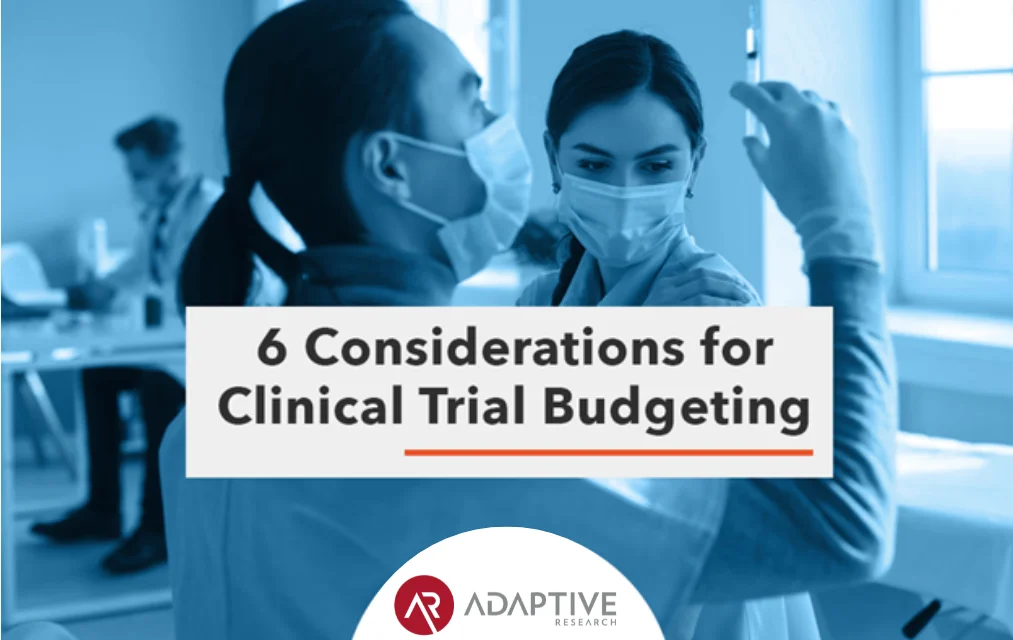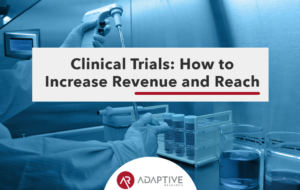In clinical research, budgeting is a key element of effective planning. To provide the best possible care to study participants, clinicians must have a budget that allows them to cover all their expenses. In other words, a clinical research budget should be balanced, enabling the clinician to have enough money to fund the necessary clinical activities while ensuring that the research center has enough to cover other expenses.
To provide a framework for clinicians, clinical research professionals should estimate the average cost for certain procedures or general expenses required by a trial. You can begin to estimate this average cost by looking at other trials within your center and understanding what previous trials have done. A close review of a few previous studies should give you a sense of what companies typically budget for specific types of activities. In addition, some groups have conducted studies about budgets in clinical research organizations (CROs). With collaborative efforts from these different sources, you stand a good chance of creating reasonable budgets that allow your organization to handle study demands and meet its other responsibilities effectively.
Consider Regulatory Costs
Costs that are not directly related to the conduct of a trial but which can have an impact on a trial’s success must be considered. Regulatory costs include licensure fees, product tracking and storage, informed consent forms, labeling changes, and equipment modifications.
Recruitment and Retention Costs
The cost of successfully recruiting human participants for clinical trials has been found to be increasing. It has also been shown that it is much more expensive to recruit people with certain characteristics. For example, older people are harder to reach, have higher refusal rates, take longer to screen, spend less time in study centers, are less compliant with treatment protocols, and have a lower retention rate than younger people.
Another factor influencing recruitment costs is the total number of eligible patients screened before finding an adequate number in the study population. The United States Federal Office for Human Research Protections (OHRP) states that the total time required to screen a potential subject should not exceed 90% of the total contact time with that person. This means that if it takes 50 minutes to screen and enroll an adequate number of subjects, then you cannot spend more than 45 minutes actually recruiting them.
This can be very important when deciding whether or not to conduct an additional study to increase the number of available subjects for future studies. If it would take two years to recruit enough new patients through traditional methods, such as advertisements and physician referrals, but only six months through another type of recruitment such as snowball sampling, then this method should be considered because it can decrease costs.
Safety Costs
The first major consideration for clinical trial budgeting is safety costs. These are the costs of ensuring that participants are kept safe throughout the study, including monitoring and any necessary treatment incurred by adverse effects. It is important to keep in mind that it can be difficult to predict the severity of adverse events before they occur, which is why some studies require longer observation periods. Furthermore, some adverse effects might not be apparent for some time after the end of the study period. A study that enrolls participants with serious health conditions can also lead to greater safety costs since more intensive monitoring may be required. Specifically, suppose a doctor has to oversee an existing condition or prescribe medication before individuals are enrolled in the clinical trial. In that case, this creates additional tasks during patient follow-up, resulting in decreased recruitment rates and increased costs. It is also important to consider the cost of lengthy procedures such as organ donation, especially if no substitute procedure is available. The most effective way to decrease safety costs is by conducting smaller trials with fewer restrictive conditions or requiring less intensive participant observation. This allows future studies to observe and learn from the trial and use results to produce a larger, more precise study.
Training materials
The costs of developing training manuals and other resources for participants and staff can be extensive, especially if they must meet multiple standards or undergo multiple revisions. One way to minimize these costs is by using existing research as a template whenever possible, such as incorporating procedures used in previous clinical trials into the new one under development. This streamlining will aid in allocating resources more efficiently during the initial phases of designing safety protocols.
Data and Quality Management
Data and quality management is crucial to clinical research. Data managers must be trained to handle various types of data, such as “hard” or paper data, which requires manual entry into the computer, and electronic data that can be directly entered into the computer. Considering that much of the information for this process comes from outside facilities, it is important to consider the time needed for transporting this information. Some facilities require training on how to use certain equipment before they allow their staff members to enter data by themselves. This aspect should also include considerations about delays in transferring data between external agencies and study groups within your organization.
Monitoring
As with any scientific experiment, monitoring must occur at all stages during the trial. Monitoring costs begin with the initial trial setup and continue throughout its duration. Monitoring determines the success or failure of a study; therefore, it is imperative to hire professional staff who can be trusted to monitor subjects appropriately. However, not all monitoring tasks are performed by professionals. For example, volunteers may be used to observe food intake during some trials.
Monitoring costs come from both internal and external facilities. Internal groups may include members of your research team; these individuals should receive adequate remuneration for their time (see Wage/Salary Information). External facilities may charge participants for office visits, blood tests, x-rays, etc. These charges must first be approved by management before they can officially be charged to the clinical trial.
Conclusion
Clinical trials follow a rigorous budgeting process. Budgets should be created and constantly monitored throughout the study and adjusted as necessary for each trial site. Further, budgets must be adhered to by all parties: sponsors, CROs, and investigators. Thus, you need to understand where your money is going and how it will be spent before establishing a budget; then, you need to monitor what actually happens (and document those results).
Learn more about the clinical trial process by contacting Adaptive Research.






